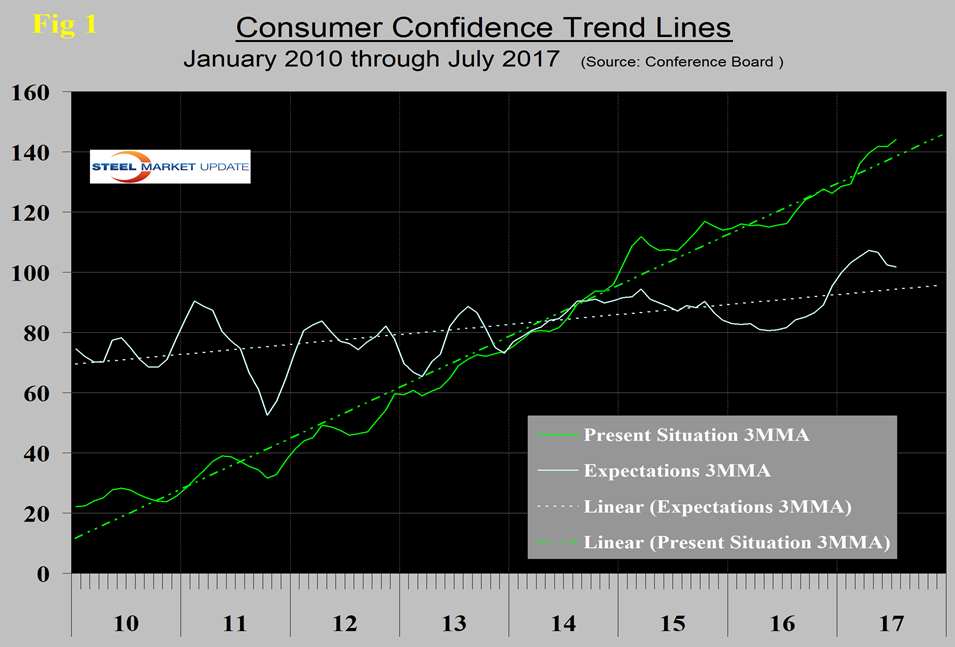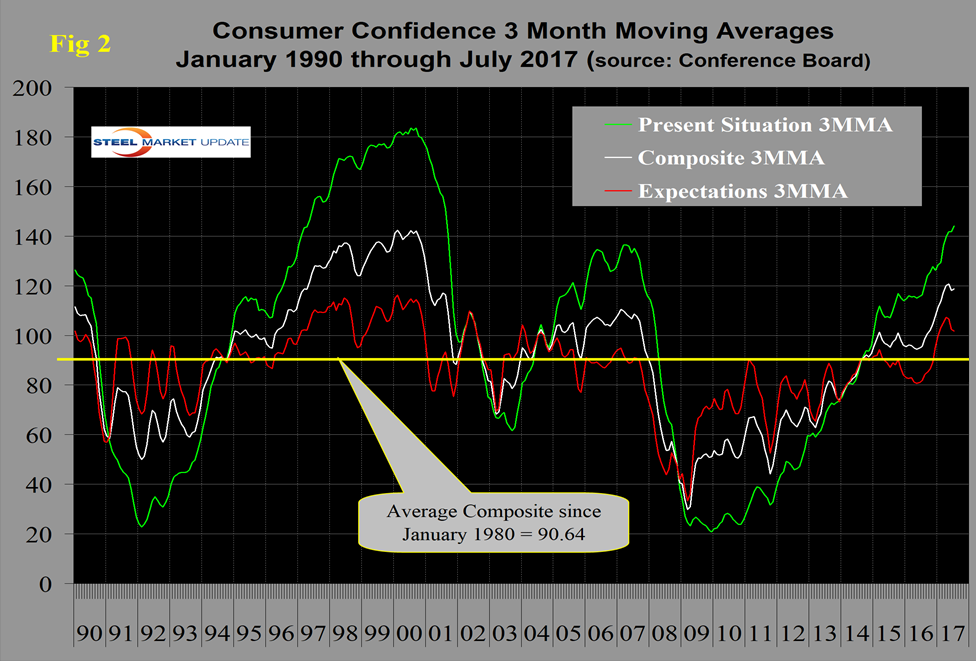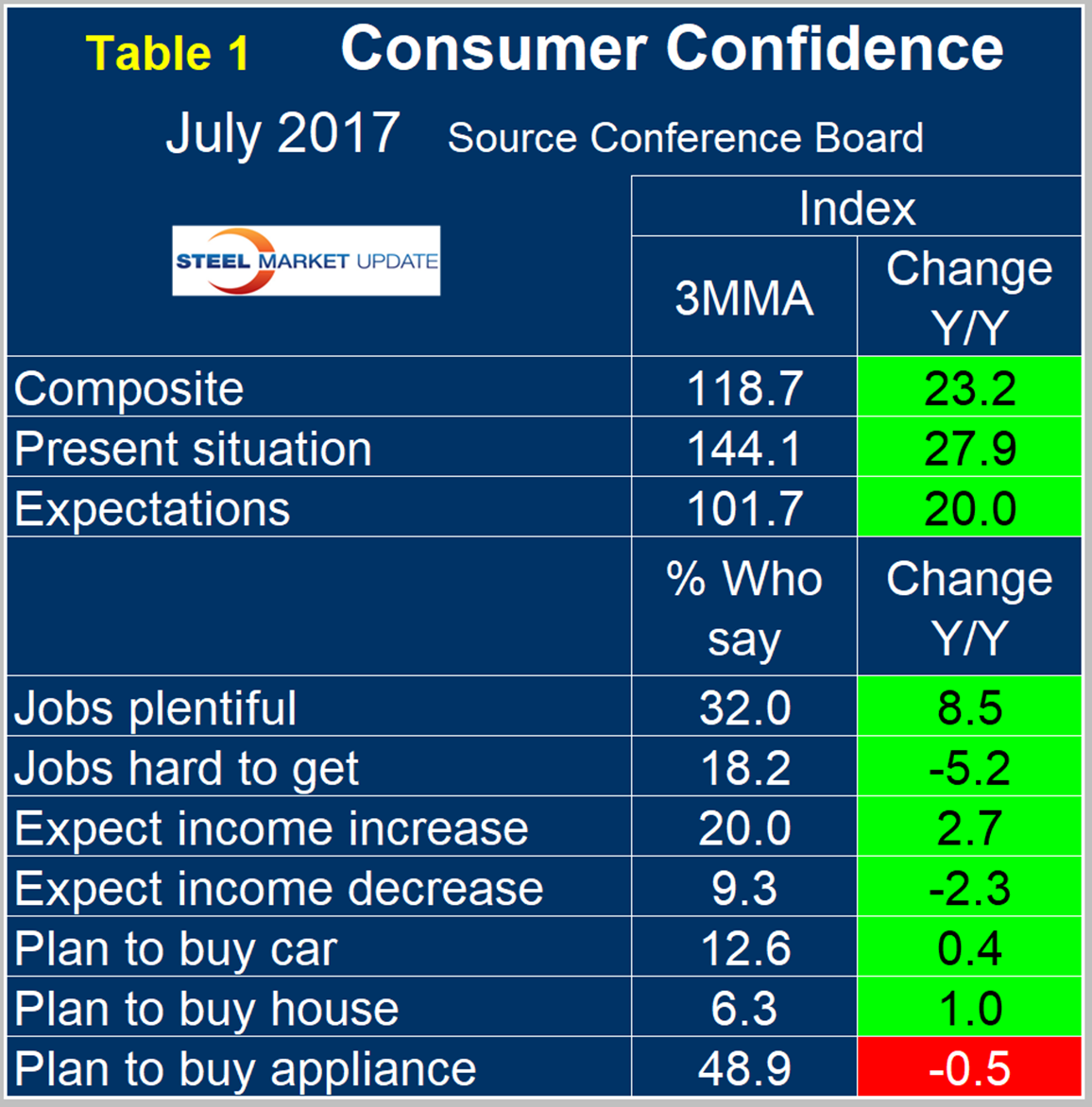Market Data

July 28, 2017
Consumer Confidence Beats Expectations in July
Written by Peter Wright
Consumers are feeling better about the present economic environment and their expectations for the future, according to data from The Conference Board, which conducts a monthly Consumer Confidence Survey. Consumer confidence is the driver of consumer spending, which is the largest component of GDP and ultimately drives a large portion of steel consumption.
![]() The composite value of consumer confidence in July hit 121.1, beating economists’ consensus expectation of 116.0 points. The July figure was an improvement on the 117.3 in June. (The index is based on 1985 = 100).
The composite value of consumer confidence in July hit 121.1, beating economists’ consensus expectation of 116.0 points. The July figure was an improvement on the 117.3 in June. (The index is based on 1985 = 100).
The last six months have each been better than at any time since 2001. The three-month moving average (3MMA) increased from 118.1 in June to 118.7 in July, which was 23.2 points higher than in July last year.
Following is an analysis of The Conference Board data by Steel Market Update. In July, the 3MMA of the composite increased by 0.57 to 118.7 points. We prefer to smooth the data with a moving average because of monthly volatility, which in the case of consumer confidence has been quite extreme since early last year. The composite index is made up of two sub-indexes: the consumer’s view of the present situation and his/her expectations for the future. Both are now above their eight-year trend line (Figure 1).
The historical pattern of the 3MMA of the composite, the view of the present situation and expectations are shown in Figure 2.
All three measures are now higher than they were at the pre-recession peak of 2007. The 3MMA of the composite made no progress from early 2015 through mid-2016 as improvements in the consumer’s view of the present situation were negated by a decline in expectations. Since mid-2016, both components of the index surged until June when expectations took a dive. It looks as though the June value for expectations was an outlier and this pulled down the 3MMA. Expectations in May were 102.3, June came in at 99.6 and July at 103.3 points. Comparing July 2017 with July 2016, the 3MMA of the composite was up by 23.2, the present situation was up by 27.9 and expectations were up by 22.0 (Table 1). All sub-indices in Table 1 were green in April, May and June, but plans to buy an appliance became negative y/y in July.
The consumer confidence report includes encouraging data on job availability and wage expectations. It reports on the proportion of people who find that jobs are hard to get and those who believe jobs are plentiful and it measures those who expect a wage increase or a decrease. Since August 2011, both the employment components have steadily improved. The difference between those finding jobs plentiful and hard to get at positive 16.0 points in July was the highest since before the recession. Expectations for wage increases have not been as consistent, but the differential between those expecting an increase and those expecting a decrease has been in positive double digits since February this year. Compared to year-ago results, plans to buy a house contracted y/y in the three months January through March, but have been positive for the last four months. Plans to buy a car have been positive every month since June last year. Plans to buy an appliance became negative y/y in July after 10 straight months of improvement.
Economy.com summarized as follows: “Consumer confidence remained quite strong in July. Despite slight drops in May and June, consumers are still much more favorable toward their present economic situation and their expectations than they were a year ago. Economic fundamentals remain solid. Personal incomes accelerated in May, and consumer spending remains steady. Labor market conditions remain robust, with several months of strong job additions at the national level, allowing job creation to outpace population growth. Unemployment ticked up last month, but so did labor force participation. Wage growth is still below where we would expect it to be in a labor market this tight, though this seems to be a factor of the current job mix, which has seen gains in lower-wage industries.”
Our take is slightly different from both Economy.com and The Conference Board’s news release below because we consider only three-month averages and the other summaries report monthly numbers.
SMU Comment: Consumer confidence continues to be historically positive, both the view of the present situation and expectations. The employment sub-indexes are good, which will drive personal consumption, the largest component of GDP. This, in turn, will have a positive effect on steel consumption.
The Conference Board’s July 25 news release follows:
The Conference Board Consumer Confidence Index, which had declined marginally in June (a downward revision), improved in July. The Index now stands at 121.1 (1985=100), up from 117.3 in June. The Present Situation Index increased from 143.9 to 147.8, while the Expectations Index rose from 99.6 last month to 103.3.
“Consumer confidence increased in July following a marginal decline in June,” said Lynn Franco, Director of Economic Indicators at The Conference Board. “Consumers’ assessment of current conditions remained at a 16-year high (July 2001, 151.3) and their expectations for the short-term outlook improved somewhat after cooling last month. Overall, consumers foresee the current economic expansion continuing well into the second half of this year.”
Consumers’ assessment of current conditions improved in July. Those saying business conditions are “good” increased from 30.6 percent to 33.3 percent, while those saying business conditions are “bad” was virtually unchanged at 13.5 percent. Consumers’ appraisal of the labor market was also more favorable. Those stating jobs are “plentiful” rose from 32.0 percent to 34.1 percent, while those claiming jobs are “hard to get” decreased slightly from 18.4 percent to 18.0 percent.
Consumers were also more optimistic about the short-term outlook in July. The percentage of consumers expecting business conditions to improve over the next six months increased from 20.1 percent to 22.9 percent, while those expecting business conditions to worsen declined from 10.0 percent to 8.2 percent.
Consumers’ outlook for the labor market improved. The proportion expecting more jobs in the months ahead was unchanged at 19.2 percent, but those anticipating fewer jobs decreased from 14.6 percent to 13.3 percent. Consumers, however, were not as upbeat about their income prospects as in June. The percentage of consumers expecting an improvement in their income declined moderately from 20.9 percent to 20.0 percent, while the proportion expecting a decline increased from 9.3 percent to 10.0 percent.










